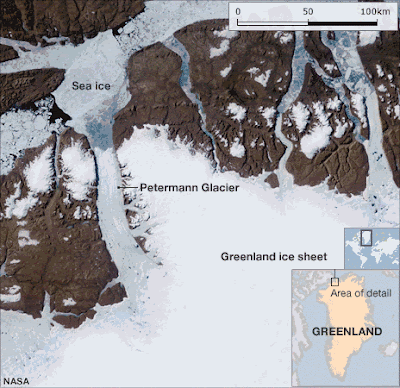On 16 July 2012 NASA's Aqua Satellite observed an iceberg measuring 120 km² (roughly 1.5 times the area of Manhattan Island or the Isle of Sheppey) the calving away from the Petermann Glacier in northern Greenland. This is not the largest iceberg ever seen calving away from Petermann, one twice this size was produced in 2010, but it is pretty large, and is part of an ongoing trend that has seen the size of the glacier greatly diminished.
False-colour satellite image of the new iceberg. Washington Post/University of Delaware.
The Petermann Glacier is a 70 × 15 km³ floating ice tongue connecting the Greenland Ice-sheet to the Arctic Ocean, along the Petermann Fjord. Like all glaciers it ebbs and flows over time. The 2010 calving event reduced the glacier's area by about 25%, and the 2012 event shrinks it to its smallest for 150 years.
The location of the Petermann Glacier. BBC/NASA.
The exact relationship between glacial calving and global temperatures in complicated, and glaciologists are (rightly) reluctant to relate any particular event to global warming. A glacier shrinking to its smallest for 150 years is not evidence that the climate has changed notably from 150 years ago, particularly as the growth and shrinkage of glaciers appears to be a cyclical event. However if the overwhelming majority of the worlds glaciers appear to be retreating at the same time, as is currently the case, then this is cause for alarm.
Melting ice in the Arctic is often linked to global sea-level rise, however this only applies to the melting of ice on-land, such as the Greenland Ice-sheet. The melting of floating glaciers such as Petermann has no effect on sea-levels, as the floating sea-ice displaces an equivalent amount of water to that produced when it melts.
See also Bowhead Whales in the Northwest Passage, Greenpeace activists occupy drilling ship in New Zealand, Were a string of volcanic eruptions responsible for the Little Ice Age? Industrialization of the East Canadian Tundra blamed for 90% drop in Caribou numbers and Greenpeace activists occupy the offices of Cairn Energy in protest at Greenland drilling.
Follow Sciency Thoughts on Facebook.


